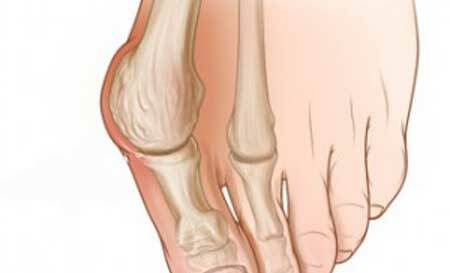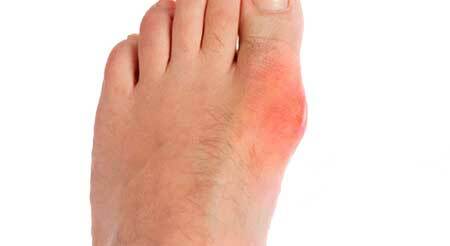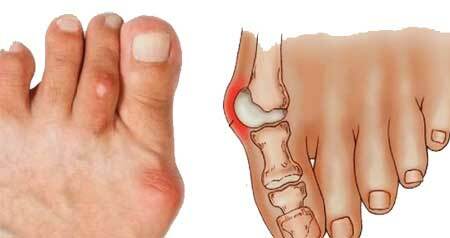Why does the bone on my leg ache near the thumb?- We are looking for the reason!
The most common cause of these pains is the development of changes in the joint connecting the metatarsal bone and the first phalanx of the big toe with the formation of a special condition called Hallux valgus, or valgus deformity of the big toe.98% of all cases of such changes in feet are observed in women.
This is due to the peculiarities of the hormonal status - the prevalence of estrogens over testosterone. Estrogens contribute to the breaking of the connective tissue, so the arch of the foot is flattened.

However, this development is characteristic only for women with hereditary predisposition or with the presence of predisposing factors, for example, prolonged wearing of heels.
This condition is characterized by the deviation of the first metatarsal bone to the inner edge of the foot with the formation of a "cone," and the thumb changes its direction and tilts to the other toes of the foot, almost perpendicular.
The deformation of the finger develops gradually and becomes permanent.
This leads to a change in the normal anatomical and functional structure of the foot. In the deformed joint, there is inflammation, which gives an answer to the question: "Why do the bones ache on the big toe?".Pain occurs first with physical exertion, and then at rest.
The formation of valgus deformation occurs for a long time. The initial period of changes in the joint is always hidden and falls to a very young age, and the first signs of the disease become noticeable only after 40 years, which sharply reduces the therapeutic possibilities, i.е.response to ongoing treatment.
Characteristic changes in the shape of the foot develop, as a rule, already in old age. At this time they are not in functional disorders, but in organic, in which the medicinal methods of action are ineffective.
The main cause of valgus deformity of the big toe is the transverse "curvature" of the forefoot, or in other words, the transverse flatfoot. He is most likely predisposed to wearing heels more than 3-4 cm in height.
In general, the causes that contribute to the formation of transverse flatfoot can be divided into internal and external. Internal causes are those that depend on the condition of the osteoarticular apparatus.

This means that they include disorders of the development or structure of bones, muscles and ligaments of the foot;diseases of the joints of the foot, common diseases. More specifically, the list of internal causative factors is as follows:
- Underdevelopment and change in the shape of metatarsal bones( dysplasia);
- Skewed articular fissures of the first metatarsus-phalangeal foot joint;
- Dysplasia of ligaments and tendons of the foot;
- Syndrome of hypermobility of joints, i.e.the state of their excessive mobility;
- Primary weakness of the muscles and ligaments of the foot( according to myography);
- Osteoarthritis of the first metatarsophalangeal joints;
- Osteoporosis is a decrease in bone density;
- Trauma of the feet;
- A family form, when Hallux valgus is observed in all women of the family.
External causes of leading to the development of transverse flatfoot are associated with a constant overload of the forefoot, which occurs when wearing shoes with high heels and / or narrow shoes. The latter leads to a violation of blood circulation and, accordingly, to the disruption of the functioning of the composite elements of the foot.
Normally, when walking, the load is divided into 3 points of the foot:
- Heads of metatarsal bones of 1 finger;
- Metatarsus of metatarsal bones; 5 fingers;
- Heel.
When the heel is worn, the load is shifted forward, with most of the load being in the middle of the foot, and the pressure on the 1 and 5 fingers is weakened. When walking stops, the middle metatarsal bones remain in place, and the metatarsal bone of the thumb turns and moves to the edge of the foot( in relation to the anatomical location - inside, that is, to the midline of the body).
The thumb is deflected to the outside, i.е.to the other toes of the foot.
The combination of frequent and prolonged wearing of such shoes with the existing internal factors leads to the gradual formation of anterior flatfoot, and then Hallux valgus.
Of course, the development of deformation of the thumb is not guaranteed for all women who wear a "high heel".However, it is necessary to think about this with a constant increased stress on the feet, as well as holders of the "Egyptian" type of foot.
The type of the foot can be determined visually and with radiography. In norm they are distinguished by three:
- square, or index plus-minus, when the first and second toe of the foot are the same in length;
- Egyptian, or index plus - the first finger is longer than the second;
- Greek, or index minus - the first finger is shorter than the second.
According to the orthopedists , the long first finger of the foot is combined with a short first metatarsal bone, which has a direct functional connection with the development of valgus deformity. Therefore, when the "Egyptian foot" is better to abandon the narrow "pins".If they need to be worn, then it is worthwhile to train them only at the event. Before that, wear orthopedic shoes with a heel less than 3 cm.
Certainly, the development of transverse flat feet is facilitated by an increase in the load on the foot with excess weight. Heavy body weight is disproportionate to the load that a foot can sustain.
Therefore, at a certain stage, its compensatory capabilities fail, which is accompanied by the formation of a transverse flatfoot.
If the big thumb bone is aching on the leg, the pain caused by valgus deformity needs to be differentiated from the pains that occur when gout is a disease when uric acid accumulates in the joints, most often in the first metacarpal phalangeal joint of the leg. The pains associated with gout have the following features:
- The association with the consumption of large amounts of animal protein, i.e.meat, as well as with the use of wine;
- Periods of exacerbation and subsidence of the disease are characteristic;
- The pain is very severe, manifestations of inflammation in the joint at the time of exacerbation are very pronounced. He blushes and swells, touching him is accompanied by the sharpest painful attacks.
The localization of pain in the first metatarsophalangeal joint is most typical for men .In women, gout, as a rule, affects the first metacarpophalangeal joint of the hand.
Contents
- 1 What to do with bone pain?
- 1.1 Diagnostics of Hallux valgus consists in carrying out:
- 2 How to get rid of the stone on the leg at home?
- 3 Treating the bones of the toes
What to do with bone pain?

It is necessary to think about the health of your feet, you need women who have discomfort when wearing familiar, previously comfortable shoes, and there is a difficulty in choosing new shoes, and if the shoes at the level of the joint of 1 finger, began to deform in the form of "bump."
- At this stage pain is still absent, the deviation of the finger is insignificant, but the pathological process in the joint has already begun.
Some sources identify these stages of the disease as cosmetic, or preclinical. The angle of the deviation of the finger is not more than 20 °( normally deviation of 1 finger is 10 °).
The second stage of is characterized by the appearance of pain after walking. The angle of deflection in the joint varies between 20-29 degrees. In this stage, the nail trails appear opposite to the 2nd and 3rd fingers, as well as corns in the interphalangeal spaces of these fingers, which signal an increasing load on the middle of the foot.
The third stage of , in addition to increasing and increasing pain, is manifested by an increase in the angle of deviation of the thumb to 30-39o and the appearance of curvature of 2 and / or 3 fingers in the form of "hammers".Also there is such a symptom as "rigidity of the forefoot", that is, the foot loses its springing properties, its transverse size decreases. The pain in this stage is constant and high intensity.
At the fourth stage of the valgus deformation, the angle of the finger deflection reaches more than 40 °, a pronounced inflammation develops in the altered joint. The skin in the region of the "cones" is coarse, thickened and inflamed. The pain forces you to wear only soft, spacious shoes. Because of this, women are very much "complexed" - they can not wear beautiful shoes and other types of shoes.
Diagnostics Hallux valgus consists in conducting:

- X-ray examination in two or three projections under load( standing);in the images, you can accurately measure the angle of the deviation of the finger, determine the degree of spreading of the foot;
- Automated planography - in this study, the graphic image of the foot under load, obtained with the scanner, is analyzed by a special program in the computer and a graphic image of the foot with all necessary parameters is given out;
If there are no symptoms, but there is a desire to check the likelihood of the disease, then the method of sub-metering, in which the foot is measured and the sub-metric index is calculated - the ratio of the length of the foot to its height:
- normal stop: index 29-30;
- flat foot: index less than 29;
- high vault: index more than 30.
At present this method has become computerized and more accurate. Previously, it was produced manually, so there was a certain percentage of the measurement error.
How to get rid of the stone on the foot at home?
If there are signs of flatfoot, it is necessary to hold regular gymnastics for feet for 10-15 minutes, 2-3 times a day:
- walking on the outer edge of the foot;
- walking on heels;
- walking on toes;
- lifting of small and narrow objects with toes;
- grabbing and spreading the toes of tissue or newspaper spread on the floor;
- standing alternately on one leg.
The therapeutic effect of these gymnastic measures can be achieved if performed regularly. In the absence of a systematic approach, the result will not be noticeable.
The initial manifestations of deformities of the thumb can be corrected using orthopedic devices: insoles and interdigital pads;apply foot massage, physiotherapy.
These effects do not eliminate the cause of the disease, so you will not be able to get rid of the "stone on your leg" at home. The treatment of this complex condition should be handled by an orthopedic doctor.
Treating the bones of the big toes
When the bones of the big toes hurt, the treatment is usually carried out combined. Particular attention is paid to weight loss, exercise therapy, optimizing the regime of the day and work, the optimal time for wearing shoes on the heel.
For anesthesia, non-steroidal agents with anti-inflammatory activity may be used, but patients with age are prescribed with caution, given the presence of concomitant diseases.
Some non-steroids, such as ibuprofen, indomethacin, when used for 4-6 months lead to aggravation of cartilage destruction, so their long-term use is undesirable.
They are only used as a temporary measure of anesthesia - until the cause is eliminated.
According to the latest data in the treatment of valgus deformity accompanied by the development of osteoarthorosis with pain syndrome, structural analogues of cartilage are widely used: chondroitin sulfate, glucosamine sulfate( or glucosamine chloride).
These drugs have good tolerability, proven efficacy and high safety, especially in elderly patients. Such drugs include: Dona, Structum, Teraflex, etc.
However, no drugs eliminate deformation of bones, so the surgical treatment of Hallux valgus is the only truly effective one so far. The choice of technique depends on the degree of deformation of the foot.
In the initial stages, it may be sufficient to perform an operation to strengthen the tendons. Later stages require intervention in bone structures with strengthening and fixing bones, removing bone deformities. After the operation, the patient undergoes a long rehabilitation course.
Unfortunately, in 30% of cases, even after surgical treatment, it is possible to return the disease. Maximum preservation of the achieved result allows strict adherence to the recommendations of the attending physician for optimization of leg health.



